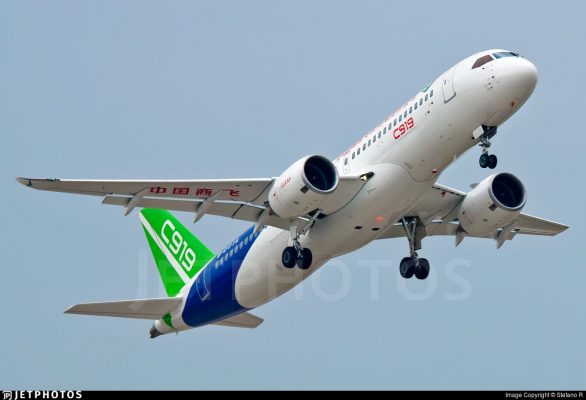
China’s homegrown C919 passenger plane completed its first public test flight earlier this month, and US aviation experts say that eventually the narrow-body jet could compete with the updated Airbus 320 and Boeing’s new generation of 737 planes.
Mike Boyd, president of aviation consultancy Boyd Group International in Evergreen, Colorado, said that on the surface the C919 is equal to the Airbus and Boeing offerings.
“It will sell well in China,” he said. “The problem the plane faces on a global scale is that airline books are filled with similar planes already on order.”
The twin-engine plane manufactured by the Commercial Aircraft Corporation of China (COMAC) has been hailed as a notable achievement in the development of the country’s civil aviation industry. “This represents the technology platform (for China) to build on going forward for the next 20 years,” Boyd said.
Brian Foley, president of a New Jersey-based aviation consultancy that bears his name, wrote in an email that the C919 could compete with the current Boeing/Airbus duopoly, particularly if it became the preferred airliner of Chinese domestic airlines.
“Globally it becomes more difficult. First, it must be approved by Western aviation authorities. Then there needs to be an adequate maintenance, sales and spare parts network worldwide,” he said. “If it’s any indication of how difficult it will be to enter the market, Bombardier’s new C Series jet has found Boeing and Airbus to be formidable competitors.”
Richard Aboulafia, a vice-president with the Teal Group Corp in Fairfax, Virginia, said that the C919 represents China’s efforts “to get into the big leagues both in terms of technology and customers”.
“If they get it right, they could be the first new competitors in this business in half a century. If it performs well and they are willing to set up a global support and finance structure for the plane which can be very expensive, then they could expand anywhere,” he said.
Scott Hamilton, managing director at the Leeham Company, an aviation consulting firm in Issaquah, Washington, said the C919 will likely become the lead airplane for a competitive Chinese aerospace/aviation industry in the future.
“It’s a mainline aircraft and it is, essentially, the proof-of-concept that China can successfully design, integrate and assemble an airliner,” Hamilton wrote in an email. “The prospective twin-aisle C929 is the next step in this process. A ‘C939′ that will inevitably follow the C929 would return to the single-aisle size and by then, China should be well on its way to a successful commercial aerospace industry. We’re looking at 20 years.”
Foley said the primary significance of the plane is the experience China gained in designing, building, testing and marketing a commercial airliner.
“This knowledge can be applied to future aircraft which will result in a shorter development cycle and improved manufacturing efficiencies. Long term this know-how will have a greater effect on the global industry than the C919 itself,” he said.


